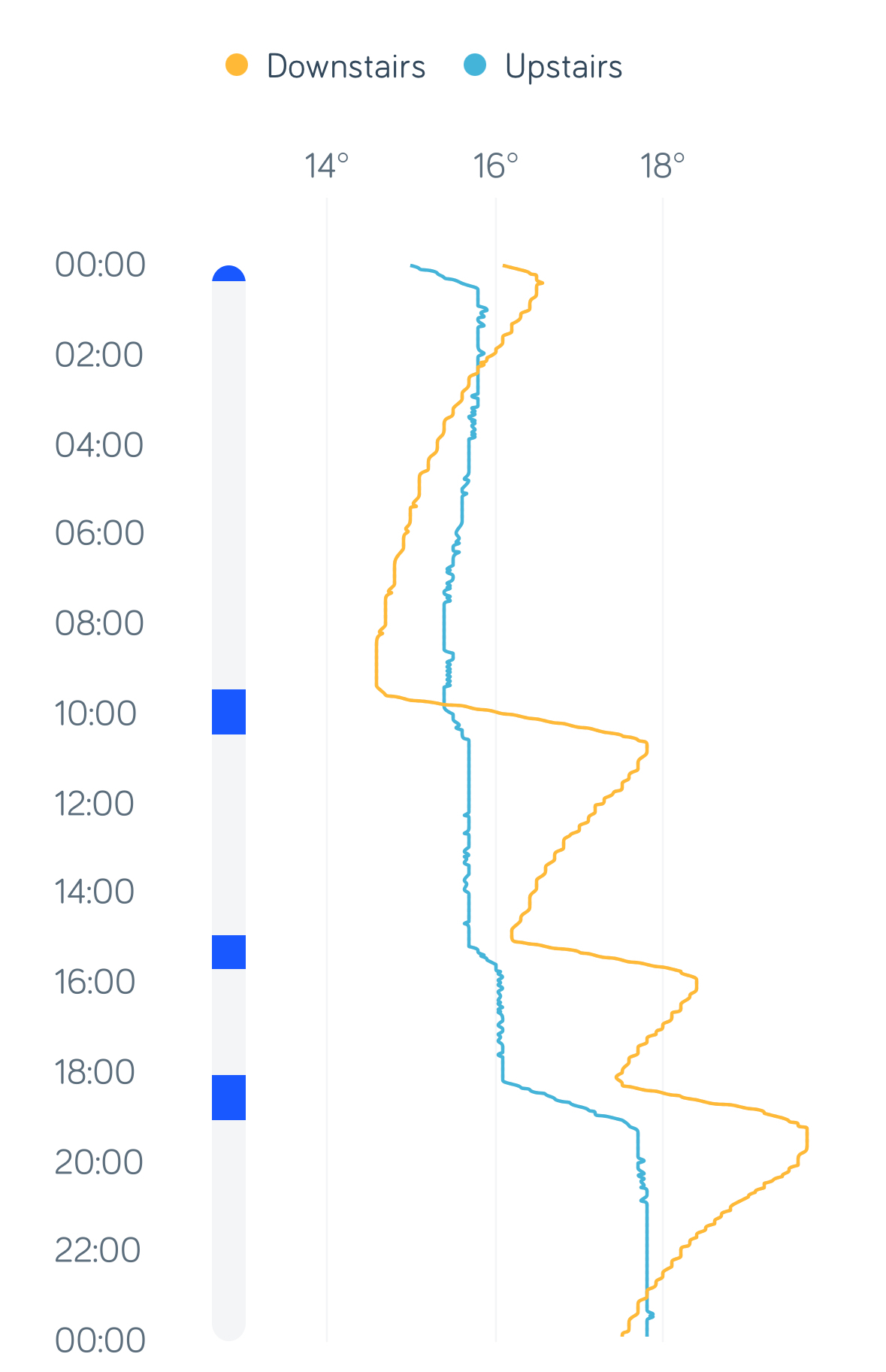We’d like to remind Forumites to please avoid political debate on the Forum.
This is to keep it a safe and useful space for MoneySaving discussions. Threads that are – or become – political in nature may be removed in line with the Forum’s rules. Thank you for your understanding.
📨 Have you signed up to the Forum's new Email Digest yet? Get a selection of trending threads sent straight to your inbox daily, weekly or monthly!
New Build Heat Loss
YesterdaysJam
Posts: 3 Newbie


in Energy
Hi all,
Recently moved in to a 4-bed detached new build (completed in June this year) and was curious if this level of heating fluctuation on the ground floor is normal or showing signs of a problem to anyone.
Admittedly I had been away for a few days before this so the house had been cold with no heating on, but it seems strange to me that the downstairs temperature would drop so rapidly with the heating off while upstairs holds almost steady? I know heat rises and the loft is well insulated, but the difference seems staggering.
Does this seem normal or is it something I should be flagging with my site manager?

Recently moved in to a 4-bed detached new build (completed in June this year) and was curious if this level of heating fluctuation on the ground floor is normal or showing signs of a problem to anyone.
Admittedly I had been away for a few days before this so the house had been cold with no heating on, but it seems strange to me that the downstairs temperature would drop so rapidly with the heating off while upstairs holds almost steady? I know heat rises and the loft is well insulated, but the difference seems staggering.
Does this seem normal or is it something I should be flagging with my site manager?

0
Comments
-
The change is less than 2C (perhaps 1.75C), although such a change is easily detectable by the human body. I agree it is odd, and could indicate that there is a draught coming from somewhere it should not. A portable thermometer that you can move around the ground floor might allow you to find which areas are colder than others, so that you have a better idea of the problem is coming from one area or is everywhere.
The cause could be a much greater heat loss due to the number of windows. I would go around the ground floor and measure the surface area of the windows, and compare this to the area of the windows upstairs. If it is just the area of the windows, some lined curtains downstairs that are shut when you are out would help reduce heat loss.
I don't think you can get expect the developer to do the investigation for you. I think you'll have to figure out if there is a problem yourself, and then turn over your findings if you think there is evidence of a problem.
The comments I post are my personal opinion. While I try to check everything is correct before posting, I can and do make mistakes, so always try to check official information sources before relying on my posts.0 -
Where is this temperature sensor in relation to radiators & other heat sources ?I have a sensor in my kitchen located a bit too close to the kettle (about 0.5m away) - Will see similar fluctuations when boiling water.. Your sensor may be a bit too close to a radiator and that might be the cause of the peaks & troughs.Any language construct that forces such insanity in this case should be abandoned without regrets. –
Erik Aronesty, 2014
Treasure the moments that you have. Savour them for as long as you can for they will never come back again.1 -
I've got the thermostat on an internal wall in the living room which backs on to the hallway and stairs, it's on the opposite side of the room to where the rad is which sits under a bay window.
I have a portable thermometer which correlates the temperature from the thermostat to within about 0.1 or 0.2 deg at all times so I'm pretty confident the thermostat is giving a reasonably accurate downstairs temp. I'm happy at how quickly it's able to come up to temperature, it just doesn't feel like it then holds on to it for as long as I was expecting for a new build.
I suppose my main confusion is why I'm immediately losing heat at something like 0.7deg an hour downstairs when upstairs seems to be able to hold on to it? Or are those numbers pretty standard?
0 -
Don't forget that your house is still going to be drying out from the construction process so this winter you may find it isn't as warm as you might think it should be. (Evaporation of the moisture in the building materials makes it feel cooler)
Our new build took a good 12-18 months or so to fully dry out and the first winter we were in it we thought something was amiss.
Turns out there was nothing wring at all and it is now toasty warm all winter.0 -
I did wonder if that would play a part, internal humidity is constantly around 70 and even running the dehumidifier it doesn't come down too much.
Would that reflect on the ground floor thermostat though causing those quicker drop offs in temp or is that more just about how warm each number actually feels?0 -
Keep it at a steady 16c or 18c this winter at least, And leave the dehumidifier on 24/7 for a week or 2.0
-
Fluctuation looks to me just like what you'd expect if concrete and cement are still drying out.As I understand this takes many months to 2 year to complete, but I don't know if there are other factors that might contribute.If the house is built on a solid concrete raft/foundation the ground floor is where the largest effect would be noticed.0
Confirm your email address to Create Threads and Reply

Categories
- All Categories
- 352.9K Banking & Borrowing
- 253.9K Reduce Debt & Boost Income
- 454.7K Spending & Discounts
- 246K Work, Benefits & Business
- 602.1K Mortgages, Homes & Bills
- 177.8K Life & Family
- 259.9K Travel & Transport
- 1.5M Hobbies & Leisure
- 16K Discuss & Feedback
- 37.7K Read-Only Boards





